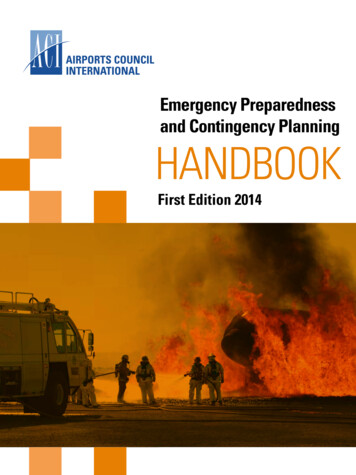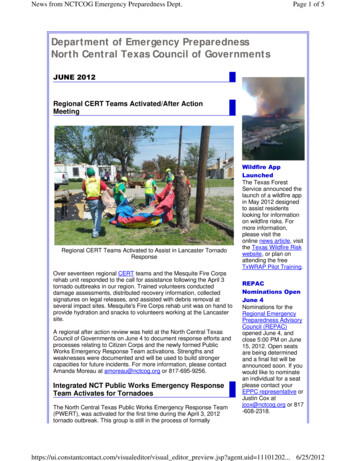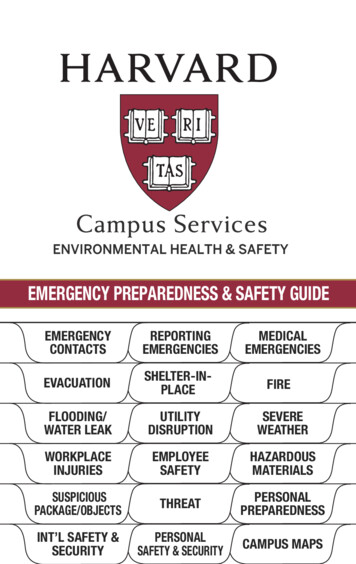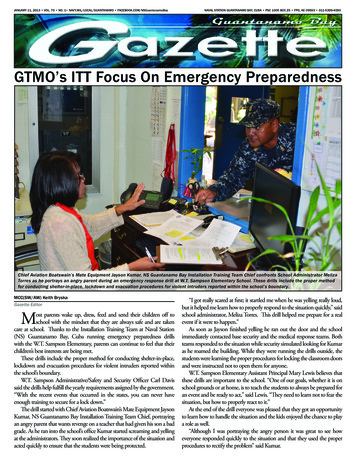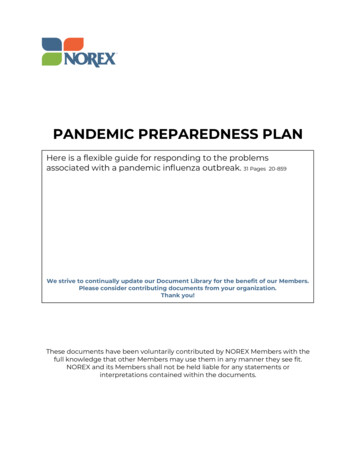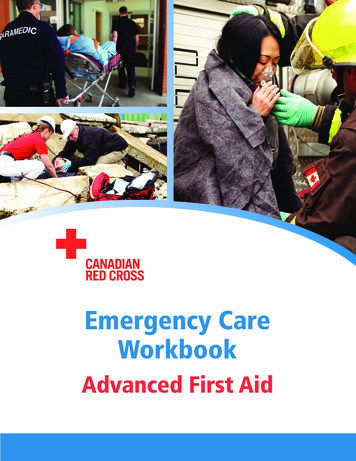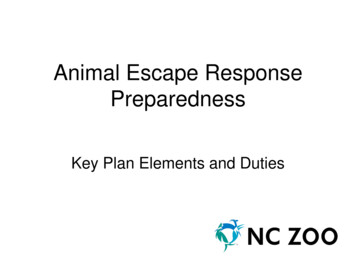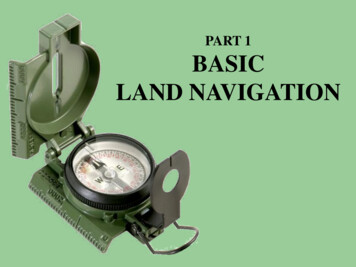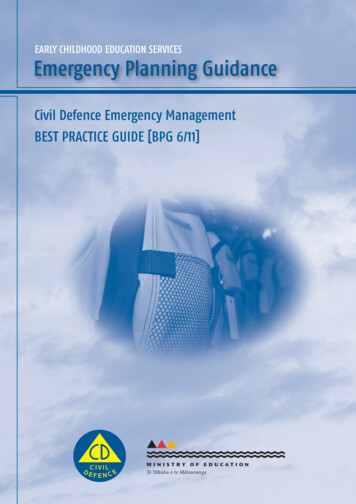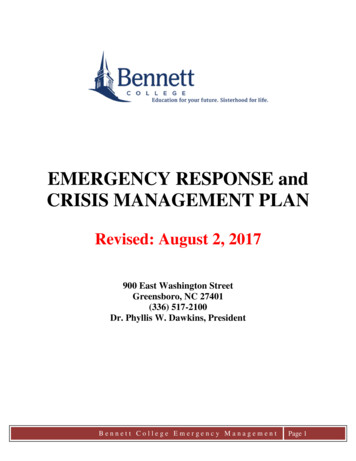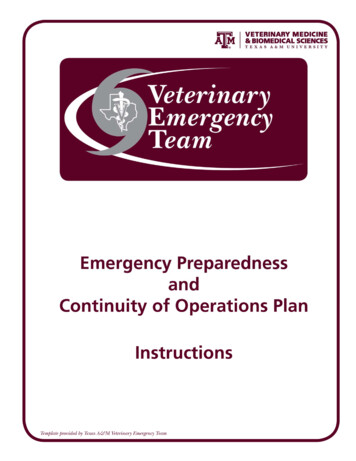
Transcription
Veterinary Practice Emergency Plan ‐ Instructions
Veterinary Practice Emergency Plan ‐ InstructionsI. PURPOSEThe purpose of this plan is to protect the health and well‐being of patients, employees and clients of(your practice name here) during times of disaster. In addition, this plan is designed to provide for thecontinuity of operations during the post‐disaster period.II. SITUATION AND ASSUMPTIONS:This section provides more focus than the general purpose statement provided above. You will need toidentify the hazards the plan are intended to address. You will be able to use the hazards your countyhas identified in the County Emergency Response Plan. You will need to delete those hazards which willnot impact animals and add additional hazards which are unique or may be isolated to your practice. Inaddition you will provide information on items you are assuming to be true as you write the plan. Anexample is provided below:The hazards identified in your county’s Animal Issues Plan are also the hazards for which this plan iswritten. In addition, hazards specific to this practice are considered. These include fire, theft, flooding,and traffic and industrial accidents near our location. Our average daily patient population is as follows:This plan is written from a worst‐case scenario, which in our county is a hurricane. Our assumptions areas follows:A. A plan written for a worst case scenario will provide ample protection for smaller‐scale disasters.B. Our practice will likely be damaged during the disaster.C. Partners and personnel will have personal issues which they need to deal with.D. Our facility will be at maximum capacity in terms of hospitalized patients at the time of disaster.E. Efforts will be made to discharge or transfer patients to other facilities prior to the disaster.F. There will be no local, regional, state, or federal assistance in evacuating our hospital.A. Meeting LocationsThis section is for the purpose of identifying a location outside of the practice for all employees to meetand a location for local patient evacuation if the practice has to be evacuated on short notice. You mayconsider selecting two local patient evacuation locations, with one being down‐prevailing and one up‐prevailing winds. Examples of locations which may be suitable as a patient evacuation location includesa colleague’s practice or the local fairgrounds. In addition you should identify a more distant patientevacuation location for instances (examples include hurricanes, floods, etc.) when your county isevacuated. Again a colleague’s practice located in another county may be a good choice. Theimportant issue to consider when choosing a location is its suitability for continuing patient care forthose animals which cannot be discharged. Provide addresses and contact information for all locations.We also recommend that you provide details on the appropriateness of the location for continuedpatient care.B. Employee InformationList all partners, associates, and employees, their contact information, and if they have a personalpreparedness plan for their own families. Requiring all involved in the practice to have complete andup‐to‐date personal preparedness plans will help to insure that all team members will be available andready to focus on getting your practice through the emergency situation.
Veterinary Practice Emergency Plan ‐ InstructionsC. Hospitalized AnimalsThis section should be used to identify all animals in your hospital at the time of the emergency. If youhave an electronic medical records system with a patient census option then you should specify that itwill be printed out at the time of the emergency. It is also a good idea to print out a daily patient censusand have one member of your hospital team take it home with them at the end of the day. This willallow complete patient information to be available should an emergency develop during non‐operational periods. If you do not have an electronic medical records system then a table should beadded here. The table should include a minimum of patient i.d. and name, a description of the patientand the owner’s name and contact information. You may also want to separate the animals into groupsto guide transportation requirements. For example, ICU and post‐operative patients will likely requirestaff capable of taking care of their medical needs during transport. Patients that are in the hospital fornon‐emergent procedures or boarding will require a lesser degree of support during transport. Inaddition you should identify a team member to populate this table with the information as soon as anemergency or disaster situation is apparent.D. Other Important NumbersDescription and NameSheriffLocal Animal ControlGas ProviderElectrical ProviderAlarm CompanyEmergency Management CoordinatorEmergency Animal HospitalBuilding ContractorTelephone/Internet ProviderPharmaceutical SupplierTexas State Board of Veterinary ExaminersTelephone NumbersIII. CONCEPT OF OPERATIONSA. Operational TimelineIn this section, define when you practice emergency response and continuity of operations plan will beinitiated. For emergencies confined to your place of business or in your community, such as anevacuation for a chemical spill or other hazard, it will be as soon as the emergency situation is apparent.For other situations for which you will have warnings, define the timeline of operations. For example, ifyour practice is in an area where tornadoes or floods are common, you may specify that certain parts ofthe plan be instituted when a watch is ordered. The plan is then escalated if and when a warning isordered. According to the National Weather Service, “a watch lets you know that weather conditionsare favorable for a hazard to occur. It literally means "be on guard!" During a weather watch, gatherawareness of the specific threat and prepare for action ‐ monitor the weather to find out if severeweather conditions have deteriorated and discuss your protective action plans with your family andhospital team members. A warning requires immediate action. This means a weather hazard isimminent ‐ it is either occurring (a tornado has been spotted, for example) ‐ or it is about to occur at anymoment. During a weather warning, it is important to take action: grab the emergency kit you have
Veterinary Practice Emergency Plan ‐ Instructionsprepared in advance and head to safety immediately. Both watches and warnings are important, butwarnings are more urgent”. If you live in a coastal community, you will want to define timelines whichprovide ample opportunity for the hospital and the families of your partners, associates and employeesto be protected. Evacuating animals, particularly large animals, requires a significant amount of timeand effort. Your plan may need to be instituted at H 72 or earlier. The Texas Animal HealthCommission defines H hour as “the time, during tropical storm/hurricane events, when tropical stormforce winds (approximately 39 mph) reach the Texas coastline. (This is not the time when the actual eyeof a hurricane reaches the Texas coast.)” Therefore, H 72 hours is 72 hours prior to the expected timeof development of tropical storm force winds.B. Patient/Animal Discharge ProceduresIn this section, provide your practice philosophy on admitting and discharging patients when faced withan impending disaster. For example, if you practice in a coastal community, will you accept animalsfrom people who are evacuating? Will you attempt to either discharge animals to their owners ortransfer animals requiring continuing veterinary medical supervision and care to an inland practice? Ifyour plan is to not accept any new admissions, discharge all patients able to be cared for by theirowners, or transfer more critical patients to inland clinics, then provide your mechanism for informingclients of these procedures and how they will be implemented.C. Employee NotificationProvide the mechanism for contacting all members of your hospital team in this section. You will wantto avoid having one person contacting all other team members. You may wish to consider establishing acalling tree. A calling tree is a pre‐defined mechanism for contacting all members. It can be as simple asa list where each person is responsible for calling the next person on the list. Another option is havingone veterinarian responsible for calling all of the veterinarians, one technician responsible for calling alltechnicians, etc.D. Patient RelocationIn this section, detail how your patients will be relocated to the local or regional patient evacuationlocations provided above. This should be a detailed part of your plan and include who is responsible forthis part of the plan, notification of patient owners, address maintenance of continuity of patient care,and define what all will be needed to accomplish the task. Maintenance of continuity of care willrequire that medical records and necessary pharmaceuticals and equipment be available at theevacuation location and provisions for providing veterinary medical assistance to critical patients duringtransport. It will also require that effective patient identification be maintained particularly if you willbe transferring care to another veterinarian. Issues to consider when detailing what will be needed toaccomplish the task should include go‐packs with medical equipment, pharmaceuticals and suppliesappropriate for your patients and boarding animals, the vehicles or transportation method to be used,personnel and equipment required for transfer of patients from your hospital to the transport vehicle,confinement of animals during transport, and personnel and equipment for transferring patients fromthe transport vehicle to the evacuation location. In addition, this part should also include providing forthe nutritional support of patients at the evacuation location.
Veterinary Practice Emergency Plan ‐ InstructionsE. Patient IdentificationProvide your method of patient identification here. This can be based on the system typically used inyour practice as long as the method supports identification during evacuation. If your current systemdoes not provide continuity of identification during evacuation, then you will need to develop a systemfor use during emergency situations. This can be as simple as numbered collars, tags, identificationcards on kennels or, paint brands (large animals). Limiting animal ID to stall or kennel cards is notrecommended as it does not guarantee the same level of continuity of animal identification as a systembased on the animals having their ID attached to or applied on them. If you are using a system relyingon identification cards on kennels or stalls, then you will need to insure that the transfer of cards occurssimultaneously with the transfer of animals.F. Medical RecordsIn this section, define how your medical records will be preserved in cases where your practice buildingis damaged or destroyed. If you are using an electronic medical records system, automatic back‐up ofyour medical records to an off‐site server or location may occur automatically. In cases where this doesnot occur, then you will need to develop back‐up protocols which include off‐site storage. Preservingpaper‐based medical records systems is more difficult as it will require physically carrying your medicalrecords off‐site in cases where evacuation is required.G. InventoryMaintaining a complete inventory of all of your equipment, supplies, and pharmaceuticals is a keycomponent of continuity of operations. Your inventory should include date of purchase, serial numbers,and purchase prices. Having copies of invoices from the time of purchase will also be helpful. Anadditional step to take is either videoing or photographing your hospital. Having a complete inventorywith supporting invoices, video or photographs will assist in filing insurance claims if your hospital isdestroyed.H. Cash, Financial Instruments, and Financial TransactionsIn this part of your plan, you should detail how you will support required hospital operations duringemergency situations. Having a secure supply of cash may prove helpful, particularly if electronicfinancial methods are unavailable. You should plan for the security of your credit cards and the abilityto accept credit cards in locations remote from your practice.I. InsuranceThe insurance section of your emergency preparedness and continuity of operations plan should beginwith annual reviews of your hospital operations with your insurance agent. Your agent will be able toguide you on maintaining appropriate levels of coverage and obtaining any additional riders. In thissection you should also provide a list of insurance of your insurance policies, policy numbers, name ofthe insurance agent(s) and contact numbers. In addition these policies should be physically protectedby maintaining copies in a water and fire‐proof safe or a secure off‐site location such as a safety depositbox. In addition, copies of your insurance policies should accompany you as you evacuate your location.
Veterinary Practice Emergency Plan ‐ InstructionsJ. Continuity of Operations (Your facility with limited infrastructure)This section should define how you will maintain operations in your hospital with limited infra‐structure.Examples of limited infra‐structure include loss of electrical power or water supply. Factors to considerinclude emergency generators, a stockpile of water and food for patients and employees, andmaintaining an acceptable working temperature in your hospital. If your plan includes owningemergency generators then emergency generator selection should be done with input from anelectrician. This will insure that the unit you select will accomplish what you want. You will also need toplan for maintaining a fuel supply for the generator. We recommend having enough fuel for a 5‐7 dayperiod. You will also need to detail the steps you will take to insure that your generator will actuallyperform when it is required.K. Continuity of Operations (local facility other than your practice)Your approach to this section of the plan will be dependent on the type of facility chosen for your localevacuation point. If your local evacuation point is a non‐veterinary medical facility, you will need to planfor all that is needed for you to provide patient care in your temporary facility. You will also need todecide on the level of veterinary care you will provide. This plan should detail the source of yourequipment, supplies, and pharmaceuticals, your method of patient confinement, maintenance ofmedical records, security of controlled pharmaceuticals, and methods used for financial transactions. Ina sense, you will have to go through the entire process of planning and designing a clinic in thetemporary facility. If your local evacuation point is at a colleague’s facility, you will need to detail howclients will be handled (will you each only see clients who have traditionally come to your practice), thepricing structure to be used, inventory control, and use of employees. This section of the plan should bedeveloped jointly with your colleague and be as exhaustive as possible in preventing potential points ofconflict.L. Continuity of Operations (regional facility other than our practice)Your approach to this section should be the same as that used in the section above.M. Security (to include fire protection and hazardous material security)In this section, detail how you will secure your facility in emergency situations. You should approach thisfrom two different perspectives. First, what steps will you take to provide structural security during anemergency? Examples may include installing storm shutters or placing plywood over windows, securingall outside items which may become projectiles in high winds, and locking gates and doors. Additionalsteps to consider include installing alarm systems and notifying law enforcement officials when you areevacuating the premises. An additional area to define is how you will maintain appropriate control ofyour controlled drug inventory. You should also provide plans for securing any hazardous materials thatare present in your practice environment.You will also need to detail the security considerations required if you are evacuating to a temporaryfacility. Planning for the security of your employees, patients, and inventory is always important. Indisaster or emergency situations, this will likely be even more important. Establish rules such as noemployee travel alone, insure that your management of controlled drug security conforms to anapplicable laws, and detail your procedures for releasing patients to their owners.
Veterinary Practice Emergency Plan ‐ InstructionsIV. ORGANIZATION AND ASSIGNMENT OF RESPONSIBILITIESProvide an organizational structure which will be used while your plan is in operation. This shouldinclude providing a list of partners, associates, and employees with assignment of specificresponsibilities for each person.V. ADMINISTRATION AND LOGISTICS:A. Financial Tracking and DocumentationIn this section, define how you will track and document expenses associated with the emergencysituation. Identify the specific person(s) responsible for this task.B. Nutritional Support (patients and employees)Provide details of how you plan to meet the nutritional needs of your patients, partners, and employeesduring the disaster. This should include plans for being completely self‐sufficient for a 3‐5 day period.Identify the specific person(s) responsible for coordinating this task.C. Housing and Sanitation (patients and employees)Provide details of how you will meet the housing needs of patients and employees during theemergency period. Again, you should plan for being self‐sufficient for a 3‐5 day period. Identify thespecific person(s) responsible for coordinating this task.D. Pharmaceuticals and Medical SuppliesProvide your plans for replenishing your stocks of pharmaceutical and medical supplies. Identify thespecific person(s) responsible for coordinating this task.VI. PLAN MAINTENANCEDefine how you will keep this plan current and who will be primarily responsible for accomplishing thistask. Identify the specific person(s) responsible for coordinating this task.
Commission defines H hour as “the time, during tropical storm/hurricane events, when tropical storm force winds (approximately 39 mph) reach the Texas coastline. (This is not the time when the actual eye of a hurricane reaches the Texas coast.)”
